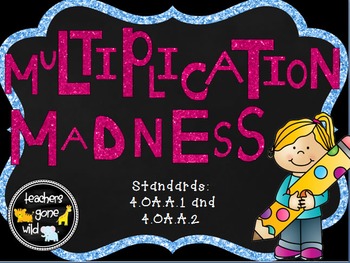Operations & Algebraic Thinking: Multiplicative Comparisons PPT and Note Taker
Gone Wild Designs
482 Followers
Grade Levels
3rd - 5th
Subjects
Resource Type
Standards
CCSS4.OA.A.1
CCSS4.OA.A.2
Formats Included
- Zip
Pages
28 pages
Gone Wild Designs
482 Followers
Description
This product is a fabulous introduction to the hard to teach operations and algebraic thinking standards. It is aligned with the 4th grade common core standards to teach students about multiplicative comparisons. It teaches students how mulitplication is a way to compare numbers. It also provides students with practice writing multiplicative comparison statements. It moves on to show students how to use bar models to solve multiplication and division word problems that involve multiplicative comparisons. A note taker is also provided that follows along with the PowerPoint. This allows students to get important notes down which still paying attention to the content of the presentation.
CCSS.MATH.CONTENT.4.OA.A.1
Interpret a multiplication equation as a comparison, e.g., interpret 35 = 5 × 7 as a statement that 35 is 5 times as many as 7 and 7 times as many as 5. Represent verbal statements of multiplicative comparisons as multiplication equations.
CCSS.MATH.CONTENT.4.OA.A.2
Multiply or divide to solve word problems involving multiplicative comparison, e.g., by using drawings and equations with a symbol for the unknown number to represent the problem, distinguishing multiplicative comparison from additive comparison.1
I hope you find this resource helpful to teach this standard, and I hope your students enjoy it as well. Please remember to leave feedback!
Kara Lee
CCSS.MATH.CONTENT.4.OA.A.1
Interpret a multiplication equation as a comparison, e.g., interpret 35 = 5 × 7 as a statement that 35 is 5 times as many as 7 and 7 times as many as 5. Represent verbal statements of multiplicative comparisons as multiplication equations.
CCSS.MATH.CONTENT.4.OA.A.2
Multiply or divide to solve word problems involving multiplicative comparison, e.g., by using drawings and equations with a symbol for the unknown number to represent the problem, distinguishing multiplicative comparison from additive comparison.1
I hope you find this resource helpful to teach this standard, and I hope your students enjoy it as well. Please remember to leave feedback!
Kara Lee
Total Pages
28 pages
Answer Key
N/A
Teaching Duration
N/A
Report this resource to TPT
Reported resources will be reviewed by our team. Report this resource to let us know if this resource violates TPT’s content guidelines.
Standards
to see state-specific standards (only available in the US).
CCSS4.OA.A.1
Interpret a multiplication equation as a comparison, e.g., interpret 35 = 5 × 7 as a statement that 35 is 5 times as many as 7 and 7 times as many as 5. Represent verbal statements of multiplicative comparisons as multiplication equations.
CCSS4.OA.A.2
Multiply or divide to solve word problems involving multiplicative comparison, e.g., by using drawings and equations with a symbol for the unknown number to represent the problem, distinguishing multiplicative comparison from additive comparison.





